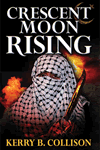Defense & Foreign Affairs Washington
Defense & Foreign Affairs [Washington D.C.]
Special Analysis
Volume XXIII, No. 98
October, 2005
New Study Maps Complex Web of Nationalist, Islamist Links and History of Indonesian, SE Asian Terrorism
Analysis. Staff Report. A new book by veteran intelligence officer and author Kerry Collison[1] hasemerged as essential reading for any analyst or official attempting to make comprehensible the complex, and often contradictory, web of historicalfactors and relationships which led to the two sets ofterrorist bombings in Bali, Indonesia, in 2002 and2005, and the array of terrorist and nationalist unconventional warfare undertakings in Indonesia and across South-East Asia over the past few decades. The study makes clear that Jamaah Islamiyah (JI) and itsrelated organizations, such as Laskar Jihad (LJ) andAbu Sayyaf, are far from finished in their mission, or their relationship with the global al-Qaida movement,and remain sustained by many aspects of the nationalist and economic societies they seek todestroy.
The book, Crescent Moon Rising,[2] was, like a number of Collison's books, written as a "fact-based politicalthriller" to enable the author to get around Indonesia's delicate libel laws as well as to placeall the historical facts into a narrative matrix which allows the broad sweep of cultures, historical developments, and characters within a framework where
the events, and people, start to make sense.
For the professional intelligence reader, the fictional narrative used to bind the historical data into a context does not get in the way of Collison's case presentation, but makes it easy reading and a way to get analysts - even those only marginally familiar with Indonesian history and politics - into a frame of reference which makes the topic intelligible. Collison has decades of experience in Indonesia, and knows virtually all of the key players on all sides of the Indonesian military and intelligence spectrum, for example. This earlier had made him perhaps the first commentator to highlight the fact that current Indonesian Pres. Susilo Bambang Yudhoyono would rise to the national leadership.
Among the things which Collison highlights are:
- The firm and clear linkage between the Indonesian Islamist movements and the al-Qaida movement of Osama bin Laden and the less-than-formal, and always fluid, way in which targeting, inter-group cooperation, and financing are achieved;
- The linkage between the terrorist groups and some key elements of the Indonesian National Military Forces (TNI: Tentara Nasional Indonesia) in the constant battle for power between the "Red and White" (nationalist) and "Green" (Islamist) elements of the TNI;
- The rôle of South-East Asian-based front companies in financing and logistical support for terrorist and insurgent groups across the region, linking Islamist activities in Indonesia, Thailand, the Philippines, Singapore, and Australia;
- The breakdowns in trust and intelligence exchanges between the US, Australia, and other players - often apparently for reasons of compartmentalization and national objectives - which enabled some terrorist operations to proceed unhindered, including the Bali 1 bombings (2002), some of the Jakarta bombings, and the September 11, 2001, attacks on the US;
- The impact of the South-East Asian economic collapse on terrorist activities;
- The rôle of the Dutch Government and secessionist elements (or elements which never supported the creation of Indonesia in the first place) within Indonesia in attempting to seek independence for the Moluccas and West Papua, and the potential rôles of the People's Republic of China (PRC) and others in possibly pushing for United Nations plebiscites on the independence of those territories;
- The resultant psychological attitudes within the TNI and Islamist movements toward Australia from Australia's late, and reluctant, rôle in assisting the independence of East Timor;
- The linkages between Laskar Jihad's activities and the "red and white" and "green" TNI factions' objectives in seeking to retain Indonesian national unity through creating, artificially, the tensions between Christian and Muslim communities in the Moluccas, Ambon, etc., leading to major rampant killing operations by Laskar Jihad and related movements, such as Komando Jihad (leading to the rise, and reinforcement of such Christian movements as the Coker boys, as well as to the Moluccan independence movement);
- Background details on the key terrorist players in the situation, including such figures as Hambali, Syafullah al-Yemeni, Omar al-Faruq, Omar Ibn al-Khattab, Ramzi Yousef, Khalid Shaikh Mohammed, Abu Sapara, and so on, and some of the intelligence players on the US and Australian side of the equation; and
- An understanding of relevant US, Indonesian, and Australian intelligence agency functions as they relate to the situation.
Collison does not neglect the linkages of the groups into Afghanistan and Chechnya, noting, quite apartfrom the concerns over the acquisition by Islamist-jihadist groups related to Osama bin Laden of "suitcase" nuclear weapons, the prospect and probability that the South-East Asian operations have acquired former Soviet Radio Thermal Generators(RTGs), which could be employed as substantial-scale "dirty" bombs.
Given the current overall climate of the US-led "waron terror", and the consequent need to create a viable and unified Indonesia (as far as the US and Australiaare concerned), and the longer-term Chinese strategic desire to see a break-up of a Western-oriented Indonesia controlling both strategic resources andstrategic waterways critical to Chinese interests,Collison's book is essential reading for analysts andpolicy officials attempting to understand thesituation. Moreover, the book brings into perspectivethe factors which lead to state sponsorship of, or acquiescence to, many aspects of terrorism.
Footnotes:
- Kerry Collison, a former Australian militaryintelligence officer, is Indonesian correspondent for Defense & Foreign Affairs/Global Information System(GIS). He is the author of numerous books on Indonesia
and South-East Asia.
- Collison, Kerry. Crescent Moon Rising. Hartwell, Victoria, Australia, 2005: Sid Harta Publishers. ISBN:1 921030 39 9. Trade paperback, 425pp; appendices,maps. http://www.sidharta.com.au.

